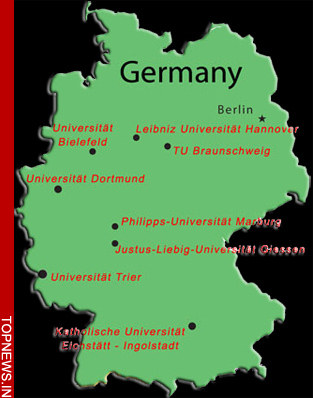Site of key ancient battle in western Germany fascinates tourist
 Berlin - A sign with the word "Varusschlacht," the German name for the Battle of Teutoburg Forest, stands beside a road, indicating drivers should turn right. When travelling around the city of Osnabrueck in western Germany signposts can be seen everywhere pointing the way to the location of this landmark battle.
Berlin - A sign with the word "Varusschlacht," the German name for the Battle of Teutoburg Forest, stands beside a road, indicating drivers should turn right. When travelling around the city of Osnabrueck in western Germany signposts can be seen everywhere pointing the way to the location of this landmark battle.
The Battle of Teutoburg Forest took place in A. D. 9 when an alliance of Germanic tribes successfully fought Roman legionaries. During the battle the Germanic tribes led by Arminius ambushed and defeated three legions of Romans led by Publius Quinctilius Varus.
Its site is believed to lie in the state of Lower Saxony between the town of Bramsche, Kalkrieser Hill and a moor. At least, that is what people around Osnabrueck believe, and most historians agree.
Today, the site of the battlefield is a very popular tourist attraction and each year 100,000 people come to see the archaeological remains that have been found there. Even more people are expected to come this year.
Two thousand years after the battle was won by the Germanic tribes, two events open to the public are to be held at the site's museum. In June, a programme of cultural events will be taking place and in July there will be a four week excavation camp for young adults.
September will also see the arrival of a 15-metre-long reconstruction of a Roman battleship on the nearby Mittelland Canal.
There has been much speculation over the exact location of the battle and there are some who doubt that it happened near the village of Kalkriese.
However, Heidrun Derks is not one of them. The archaeologist designed the museum's new permanent exhibition and has expert knowledge of the items on display.
"Roman coins were found here in the 17th century," she points out. Later, a Roman sling shot was also discovered. They are just two pieces of evidence found here that indicate the battle did indeed take place near Kalkriese.
When Derks began working on the excavations 20 years ago, she and her colleagues quickly made some spectacular discoveries. One of the them was a mask made from iron. "The mask is the centre piece of our exhibition."
During the excavations the remains of a 400-metre-long earthen wall was discovered that shows the ambush was planned long in advance.
The archaeologists also found pieces of human bone which would confirm a description by the Roman general Germanicus of a reburial that took place after the battle. "They are all strong indicators that Kalkriese was the spot," says Derks.
A section of the exhibition is dedicated to the different cultures of the ancient Romans and Germanic peoples. A model of a Roman villa stands beside a Germanic farm house and life in a Roman town is compared to that in a Germanic village.
Another model vividly illustrates just how badly the cards were stacked against the Romans. The model shows the landscape around Kalkriese, including the narrow strip of land between the marshland and Kalkriese Hill.
At the touch of a button visitors can release 4,000 small metal ball bearings that roll along the path followed by the Roman legionaries. Hardly any of them can avoid the area's natural barriers.
The exhibition also deals with the conflicts between the Romans and the Germanic tribes in the section called "Empire, Conflict, Myth".
Two parallel exhibitions are also taking place in Haltern am See and in Detmold. "The exhibitions do not deal with the battle," says archaeologist Stefan Burmeister. "We explain why the Germans repeatedly sought conflict with the Romans and fought against them."
One of the important reasons for the steady conflict was loot. The exhibition contains a display case with a collection of pots, pans and table silverware found near Neupotz that had been taken by the Germans from the Romans.
Information: Guided tours through Park Kalkriese can be booked at +49 5468 920 42 00 or by e-mail: fuehrungen@kalkriese-varusschlacht.de
Internet: www. kalkriese-varusschlacht. de, www. imperium-konflikt-mythos. de
Museum and Park Kalkriese: Venner Strasse 69, Bramsche-Kalkriese. (dpa)